The Optimization of Segmented Reaming Parameters and the Analysis of the Pressure Relief Effect in Impacted Coal Seams
Abstract
1. Introduction
2. Technological Mechanism of Segmented Reaming
2.1. Pressure Relief Effect of Conventional, Large-Diameter Drilling
2.1.1. Overview of the Working Face
2.1.2. Analysis of Roadway Deformation
2.2. Pressure Relief Mechanism of Segmented Reaming Technology
3. Test Room Study of Segmented Reaming Pressure Relief
3.1. Test Procedure
3.1.1. Preparation of Test Materials
3.1.2. Test Scheme Design
3.2. Test Results and Analysis
3.2.1. Test Scheme 1: Different Reaming Diameters
- (1)
- Analysis of pressure relief effect
- (2)
- Failure form and crack development of specimens
3.2.2. Test Scheme 2: Different Reaming Depth
- (1)
- Pressure relief effect analysis
- (2)
- Failure mode and crack development of specimens
3.2.3. Test Scheme 3: Different Borehole Spacings
- (1)
- Analysis of pressure relief effect
- (2)
- Failure mode and crack development of specimens
4. Research on the Layout Optimization of Segmented Reaming Parameters
4.1. Simulation Design of Segmented Reaming Parameter Arrangement
4.2. Simulation Results and Analysis
4.2.1. Simulation Scheme 1: Simulation Results Analysis
- (1)
- Energy release characteristics of the surrounding rocks of the roadway
- (2)
- Deformation characteristics of the surrounding rocks of the roadway
4.2.2. Simulation Scheme 2: Simulation Results Analysis
- (1)
- Energy release characteristics of the surrounding rocks of the roadway
- (2)
- Deformation characteristics of the tunnel surrounding the rock
4.2.3. Simulation Scheme 3: Simulation Results Analysis
- (1)
- Energy release characteristics of the surrounding rocks of the roadway
- (2)
- Deformation characteristics of surrounding rocks of the roadway
5. Results and Discussion
5.1. Results
- (1)
- Effect test of stress release measurements of segmented reaming
- (2)
- Deformation observation of the surrounding rocks of the roadway
- (3)
- Construction efficiency analysis
5.2. Discussion
6. Conclusions and Outlook
Author Contributions
Funding
Data Availability Statement
Conflicts of Interest
References
- Zhang, C.; Canbulat, I.; Hebblewhite, B.; Ward, C.R. Assessing coal burst phenomena in mining and insights into directions for future research. Int. J. Coal Geol. 2017, 179, 28–44. [Google Scholar] [CrossRef]
- Li, T.; Cai, M.F.; Cai, M. A review of mining-induced seismicity in China. Int. J. Rock Mech. Min. Sci. 2007, 44, 1149–1171. [Google Scholar] [CrossRef]
- Yan, P.; Zhao, Z.; Lu, W.; Fan, Y.; Chen, X.; Shan, Z. Mitigation of rock burst events by blasting techniques during deep-tunnel excavation. Eng. Geol. 2015, 188, 126–136. [Google Scholar] [CrossRef]
- Dou, L.-M.; Mu, Z.-L.; Li, Z.-L.; Cao, A.-Y.; Gong, S.-Y. Research progress of monitoring, forecasting, and prevention of rockburst in underground coal mining in China. Int. J. Coal Sci. Technol. 2014, 1, 278–288. [Google Scholar] [CrossRef]
- Jiang, Y.; Wang, H.; Xue, S.; Zhao, Y.; Zhu, J.; Pang, X. Assessment and mitigation of coal bump risk during extraction of an island longwall panel. Int. J. Coal Geol. 2012, 95, 20–33. [Google Scholar] [CrossRef]
- Hosseini, N. Evaluation of the rockburst potential in longwall coal mining using passive seismic velocity tomography and image subtraction technique. J. Seismol. 2017, 21, 1101–1110. [Google Scholar] [CrossRef]
- Mazaira, A.; Konicek, P. Intense rockburst impacts in deep underground construction and their prevention. Can. Geotech. J. 2015, 52, 1426–1439. [Google Scholar] [CrossRef]
- Hongwei, W.; Yaodong, J.; Jie, Z.; Ruyue, S.; Chen, W. Numerical investigation on the assessment and mitigation of coal bump in an island longwall panel. Int. J. Min. Sci. Technol. 2013, 23, 625–630. [Google Scholar] [CrossRef]
- Li, Z.L.; Dou, L.M.; Cai, W.; Wang, G.F.; Ding, Y.L.; Kong, Y. Roadway stagger layout for effective control of gob-side rock bursts in the longwall mining of a thick coal seam. Rock Mech. Rock Eng. 2016, 49, 621–629. [Google Scholar] [CrossRef]
- Liu, H.B.; Zhao, Y.X.; Jiang, Y.D.; Wang, H. Large diameter borehole pressure relief and disaster prevention technology in fully mechanized caving face. Saf. Coal Mines 2018, 9, 79–82. (In Chinese) [Google Scholar]
- Lei, X.Y.; Zhu, X.W. Simulated analysis of pressure relief by forward drilling in high stress roadway. Saf. Coal Mines 2015, 46, 175–178. (In Chinese) [Google Scholar]
- Zhao, T.B.; Guo, W.Y.; Tan, Y.L.; Lu, C.P.; Wang, C.W. Case histories of rock bursts under complicated geological conditions. Bull. Eng. Geol. Environ. 2017, 77, 1529–1545. [Google Scholar] [CrossRef]
- Li, Y.P.; Zhang, H.W.; Zhu, Z.J.; Chao, G. Study on safety parameters of pressure relief boreholes in percussive dangerous coal seams. China Saf. Sci. J. 2018, 28, 122–128. (In Chinese) [Google Scholar]
- Zhang, S.C.; Li, Y.Y.; Shen, B.T.; Sun, X.Z.; Gao, L.Q. Effective evaluation of pressure relief drilling for reducing rock bursts and its application in underground coal mines. Int. J. Rock Mech. Min. Sci. 2019, 114, 7–16. [Google Scholar] [CrossRef]
- Meier, T.; Rybacki, E.; Reinicke, A.; Dresen, G. Influence of borehole diameter on the formation of borehole breakouts in black shale. Int. J. Rock Mech. Min. Sci. 2013, 62, 74–85. [Google Scholar] [CrossRef]
- Huang, B.; Guo, W.Y.; Fu, Z.Y.; Zhao, T.B.; Zhang, L.S. Experimental Investigation of the Influence of Drilling Arrangements on the Mechanical Behavior of Rock Models. Geotech. Geol. Eng. 2018, 36, 2425–2436. [Google Scholar] [CrossRef]
- Jia, C.; Jiang, Y.; Zhang, X.X. Laboratory and numerical experiments on pressure relief mechanism of large-diameter boreholes. Chin. J. Geot. Eng. 2017, 39, 1115–1122. (In Chinese) [Google Scholar]
- Shen, B.; Stephansson, O.; Rinne, M. Simulation of borehole breakouts using fracod (2d). Oil Gas Sci. Technol. 2002, 57, 579–590. [Google Scholar] [CrossRef]
- Song, D.; Wang, E.; Li, Z.; Liu, J.; Xu, W. Energy dissipation of coal and rock during damage and failure process based on EMR. Int. J. Min. Sci. Technol. 2015, 85, 17–30. [Google Scholar] [CrossRef]
- Sainoki, A.; Mitri, H.S. Dynamic modelling of fault-slip with Barton’s shear strength model. Int. J. Rock Mech. Min. Sci. 2014, 67, 155–163. [Google Scholar] [CrossRef]
- Wang, L.; Lu, Z.L.; Gao, Q. A numerical study of rock burst development and strain energy release. Int. J. Min. Sci. Technol. 2012, 22, 675–680. [Google Scholar] [CrossRef]
- Zhao, Y.X.; Jiang, Y.D. Acoustic emission and thermal infrared precursors associated with bump-prone coal failure. Int. J. Coal Geol. 2010, 83, 11–20. [Google Scholar] [CrossRef]
- Prusek, S.; Masny, W. Analysis of damage to underground workings and their supports caused by dynamic phenomena. J. Min. Sci. 2015, 51, 63–72. [Google Scholar] [CrossRef]
- Guo, W.-Y.; Zhao, T.-B.; Tan, Y.-L.; Yu, F.-H.; Hu, S.-C.; Yang, F.-Q. Progressive mitigation method of rock bursts under complicated geological conditions. Int. J. Rock Mech. Min. Sci. 2017, 96, 11–22. [Google Scholar] [CrossRef]
- Zhao, T.-B.; Guo, W.-Y.; Tan, Y.-L.; Yin, Y.-C.; Cai, L.-S.; Pan, J.-F. Case studies of rock bursts under complicated geological conditions during multi-seam mining at a depth of 800 m. Rock Mech. Rock Eng. 2018, 51, 1539–1564. [Google Scholar] [CrossRef]
- Wang, W.; Yuan, Y.; Chen, Z.; Zhu, C. Physical Modeling of Floor Failure Above Confined Water: A Case Study in China. Environ. Earth Sci. 2022, 81, 325. [Google Scholar] [CrossRef]
- Zhu, C.; Yuan, Y.; Wang, W.; Chen, Z.; Zhong, H. Research On the “Three Shells” Cooperative Support Technology of Large-Section Chambers in Deep Mines. Int. J. Min. Sci. Technol. 2021, 31, 665–680. [Google Scholar] [CrossRef]
- Yuan, Y.; Yuan, C.; Zhu, C.; Liu, H.; Wang, S. Study on the Disaster Reduction Mechanism of Presplitting Blasting and Reasonable Blasting Parameters for Shallowly Buried Remnant Pillars. Energy Sci. Eng. 2019, 7, 2884–2894. [Google Scholar] [CrossRef]
- Zhou, F.; Sun, W.; Shao, J.; Kong, L.; Geng, X. Experimental Study on Nano Silica Modified Cement Base Grouting Reinforcement Materials. Geomech. Eng. 2020, 20, 67–73. [Google Scholar]
- Song, W.; Liang, Z. Theoretical and Numerical Investigations on Mining-Induced Fault Activation and Groundwater Outburst of Coal Seam Floor. Bull. Eng. Geol. Environ. 2021, 80, 5757–5768. [Google Scholar] [CrossRef]
- Wang, W.; Yuan, Y.; Liang, X.; Qin, Z.; Chen, Z.; Ding, K.; Xia, Y.; Yan, C. Experimental Study on Floor Damage and Slurry Material Ratio Optimization in Deep and High Confined Water Mining. Processes 2022, 10, 1806. [Google Scholar] [CrossRef]
- Zhu, C.; Yuan, Y.; Yuan, C.; Liu, F.; Chen, Z.; Wang, S. Study on the Structural Forms of the Key Strata in the Overburden of a Stope During Periodic Weighting and the Reasonable Working Resistance of the Support. Energy Sci. Eng. 2020, 8, 2599–2620. [Google Scholar] [CrossRef]
- Sun, Y.; Zhang, P.; Yan, W.; Wu, J.; Yan, F. Grouting Material Development and Dynamic Grouting Test of Broken Rock Mass. J. Mater. Civ. Eng. 2022, 34, 4022072. [Google Scholar] [CrossRef]
- Hu, Y.; Li, W.; Wang, Q.; Liu, S.; Wang, Z. Study on Failure Depth of Coal Seam Floor in Deep Mining. Environ. Earth Sci. 2019, 78, 697. [Google Scholar] [CrossRef]
- Xu, Z.; Sun, Y.; Gao, S.; Chen, H.; Li, X. Comprehensive Exploration, Safety Evaluation and Grouting of Karst Collapse Columns in the Yangjian Coalmine of the Shanxi Province, China. Carbonates Evaporites 2021, 36, 16. [Google Scholar] [CrossRef]
- Yu, S.; Xu, J.; Zhu, W.; Wang, S.; Liu, W. Development of a Combined Mining Technique to Protect the Underground Workspace Above Confined Aquifer from Water Inrush Disaster. Bull. Eng. Geol. Environ. 2020, 79, 3649–3666. [Google Scholar] [CrossRef]
- Liang, Z.; Song, W.; Liu, W. Theoretical Models for Simulating the Failure Range and Stability of Inclined Floor Strata Induced by Mining and Hydraulic Pressure. Int. J. Rock Mech. Min. Sci. 2020, 132, 104382. [Google Scholar] [CrossRef]
- Zhu, C.; Yuan, Y.; Chen, Z.; Meng, C.; Wang, S. Study of the Stability Control of Rock Surrounding Longwall Recovery Roadways in Shallow Seams. Shock Vib. 2020, 2020, 1–22. [Google Scholar] [CrossRef]

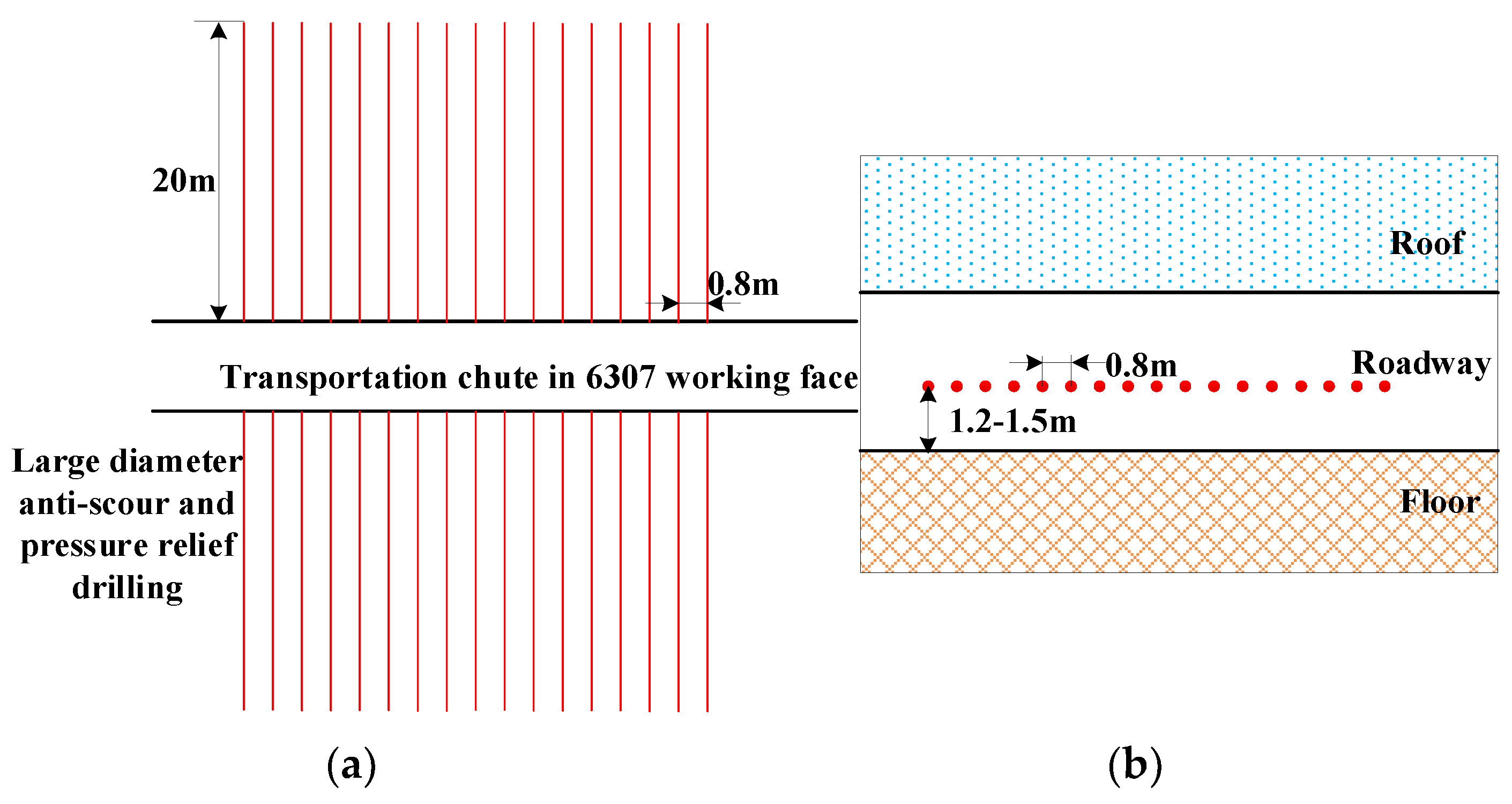
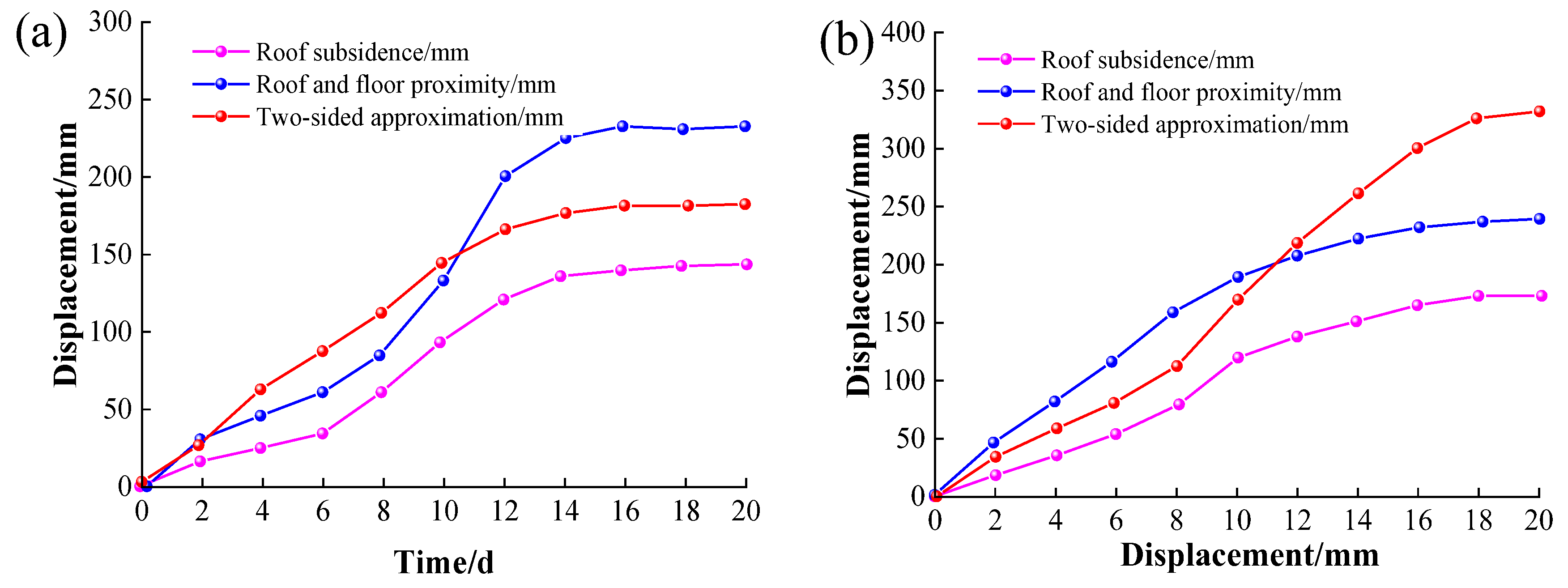

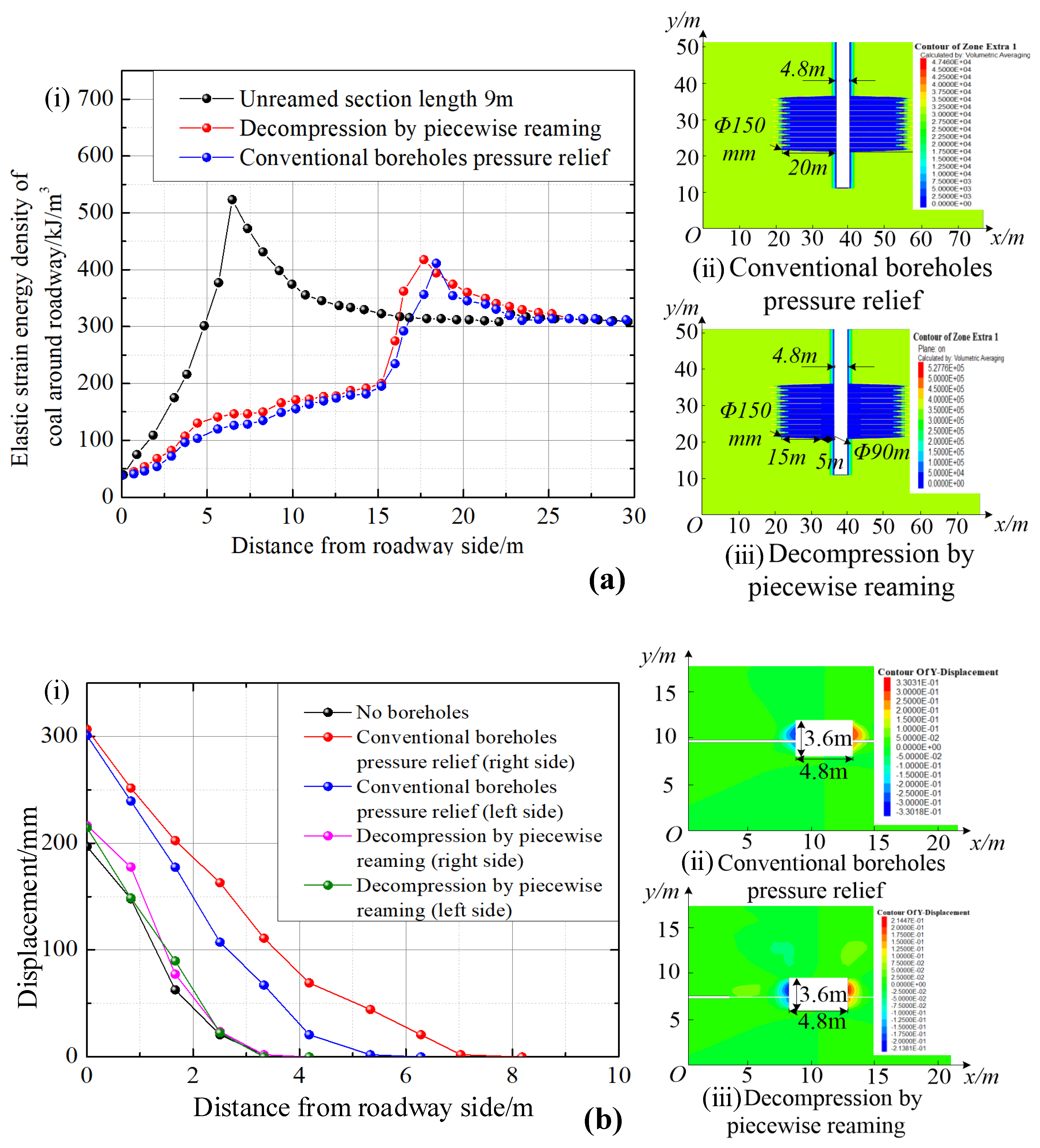

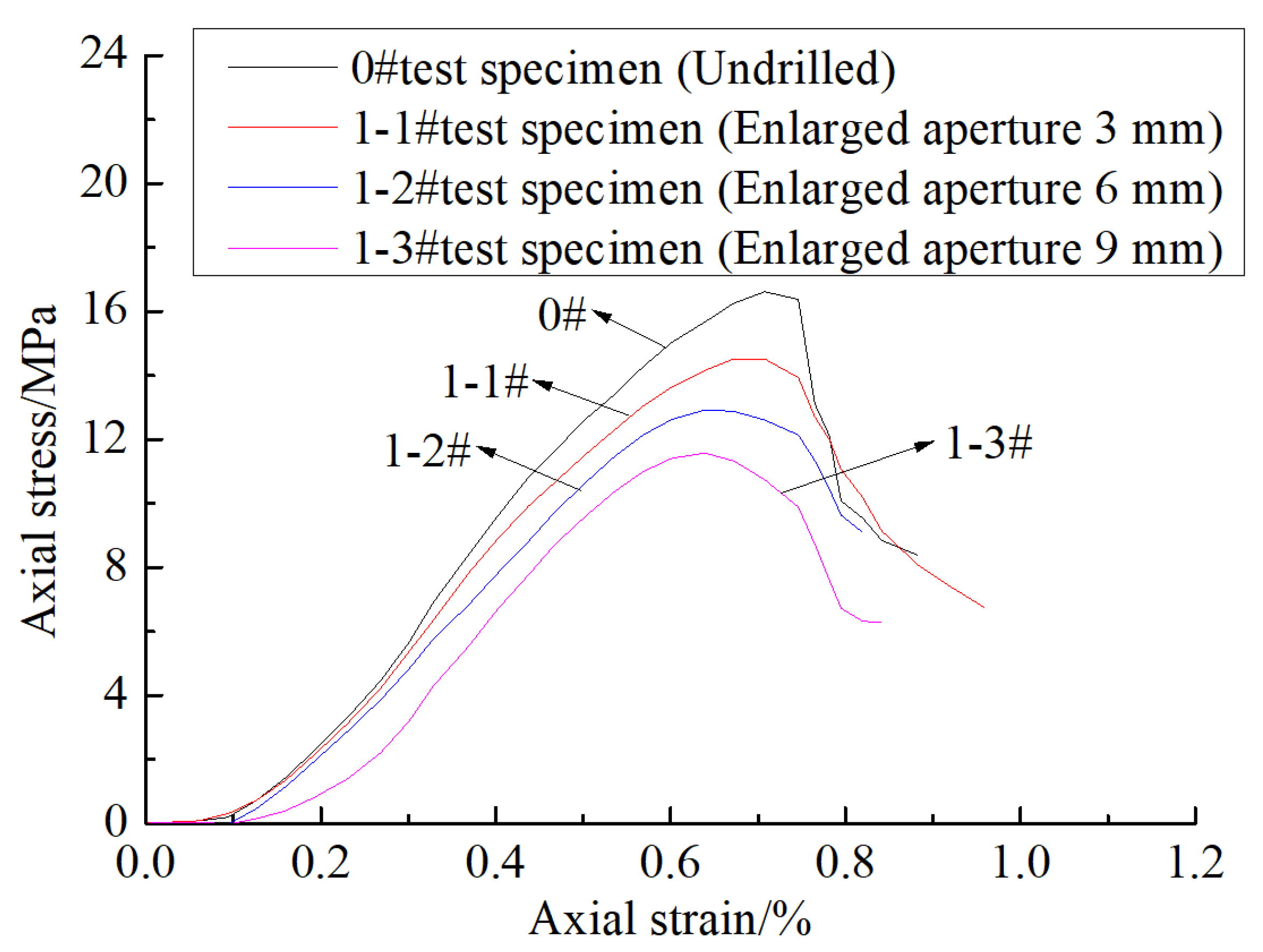
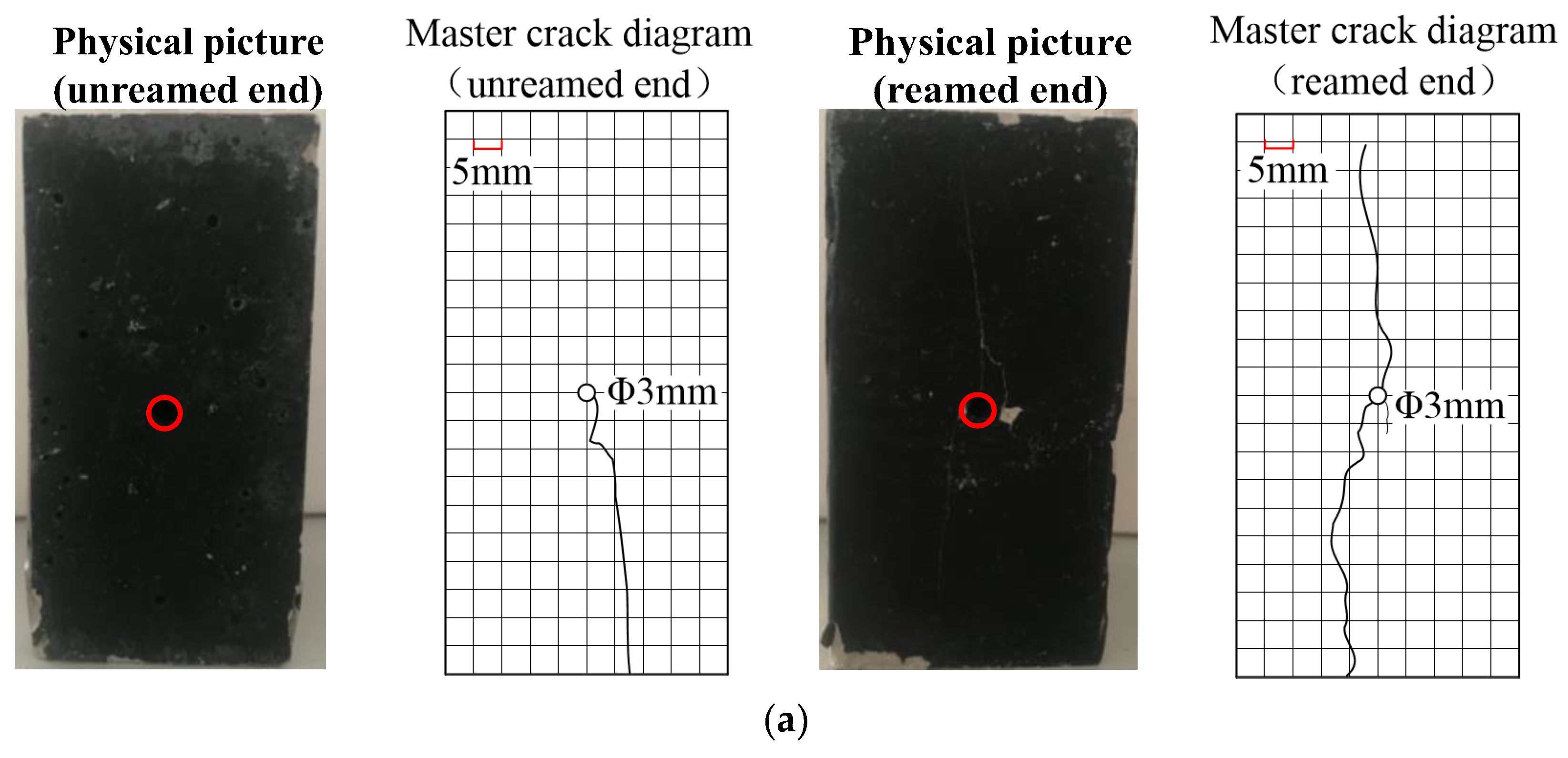
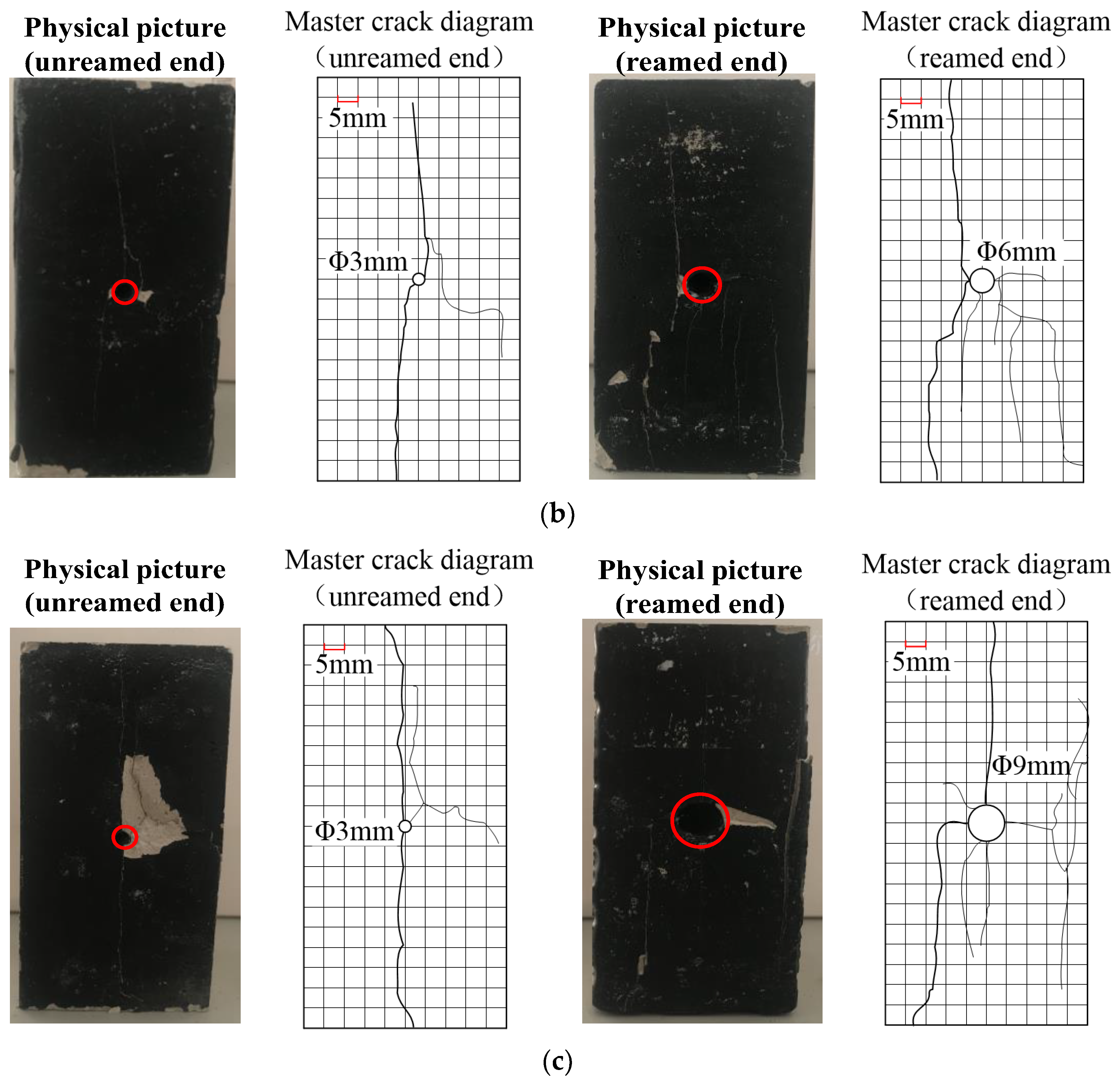

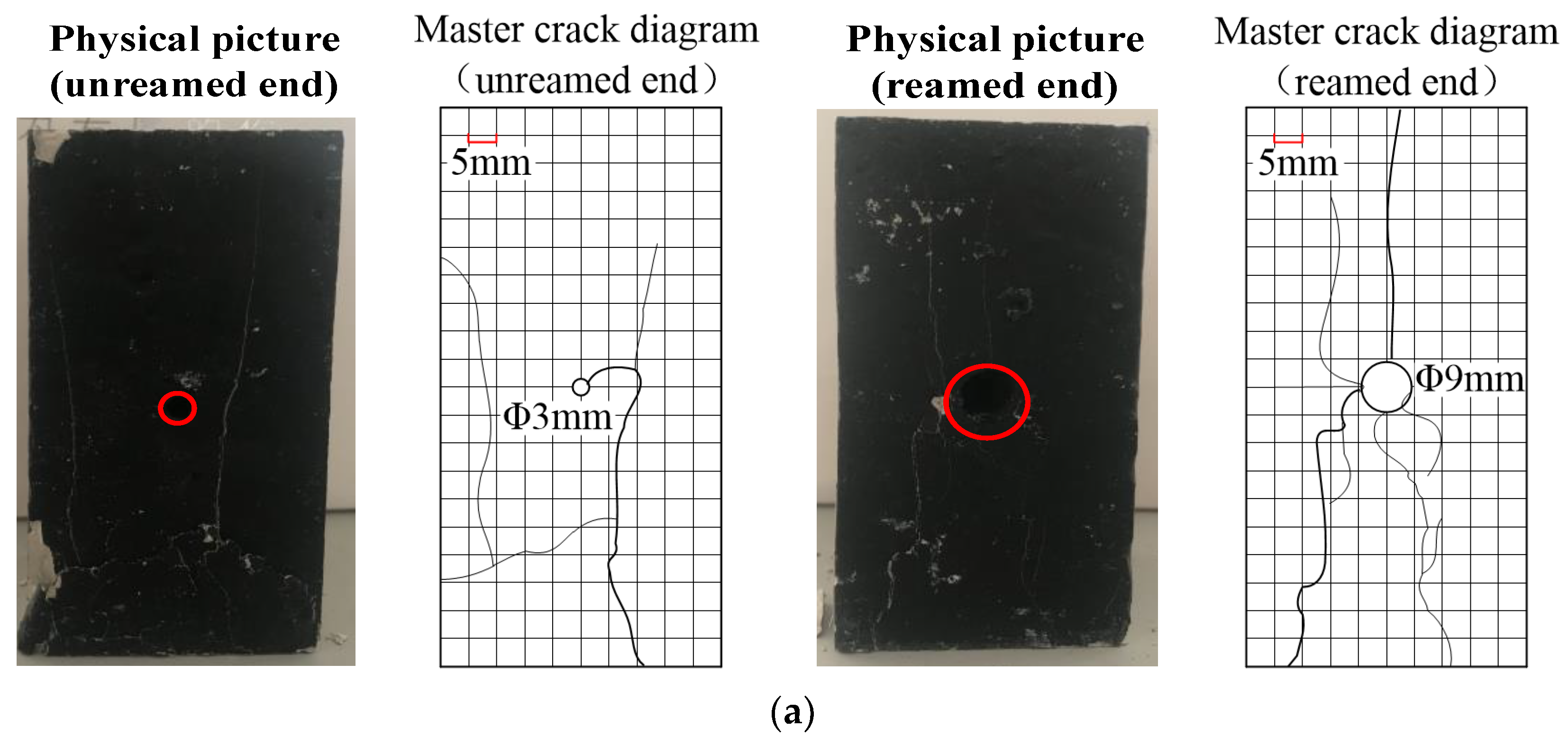
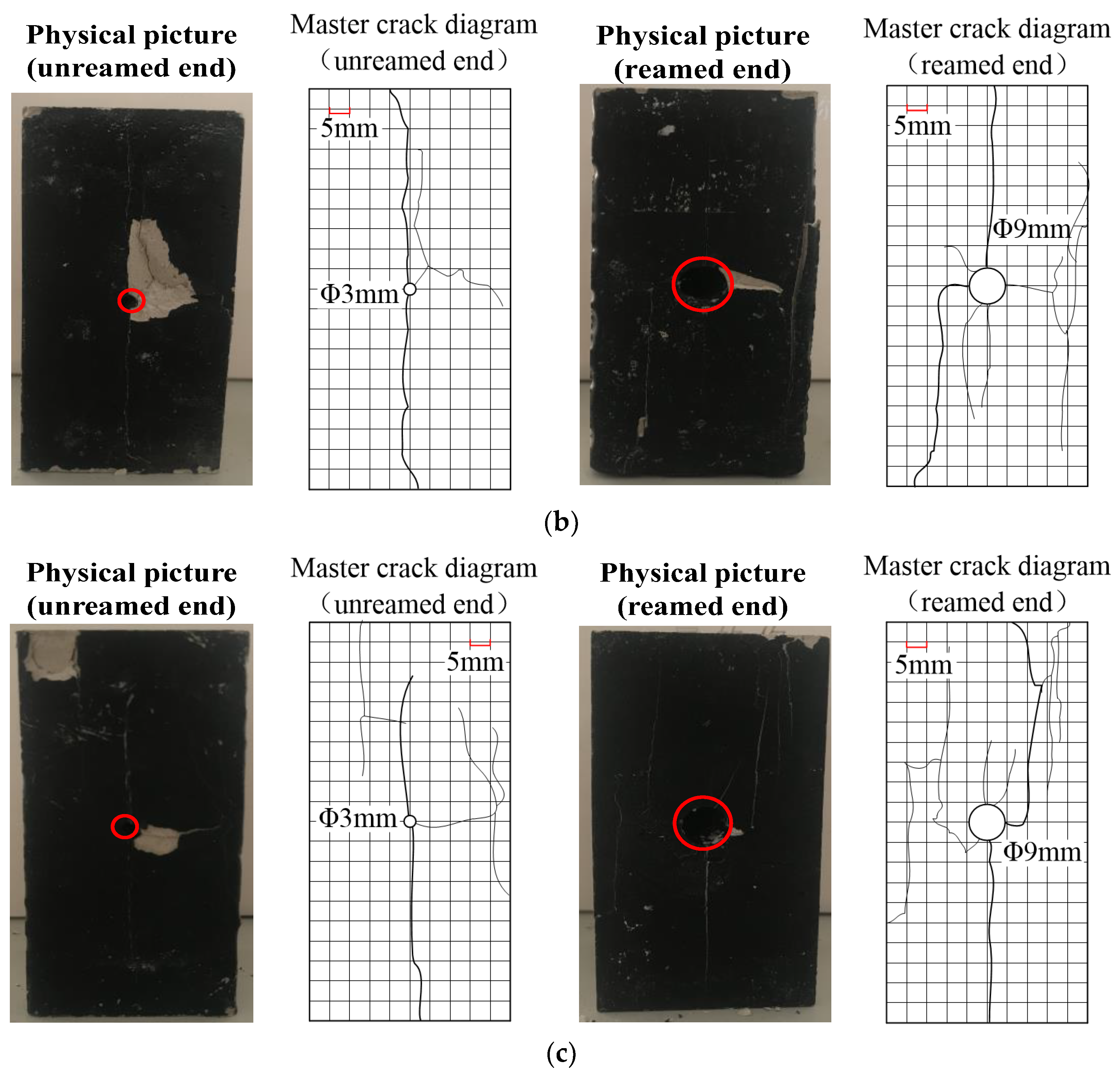

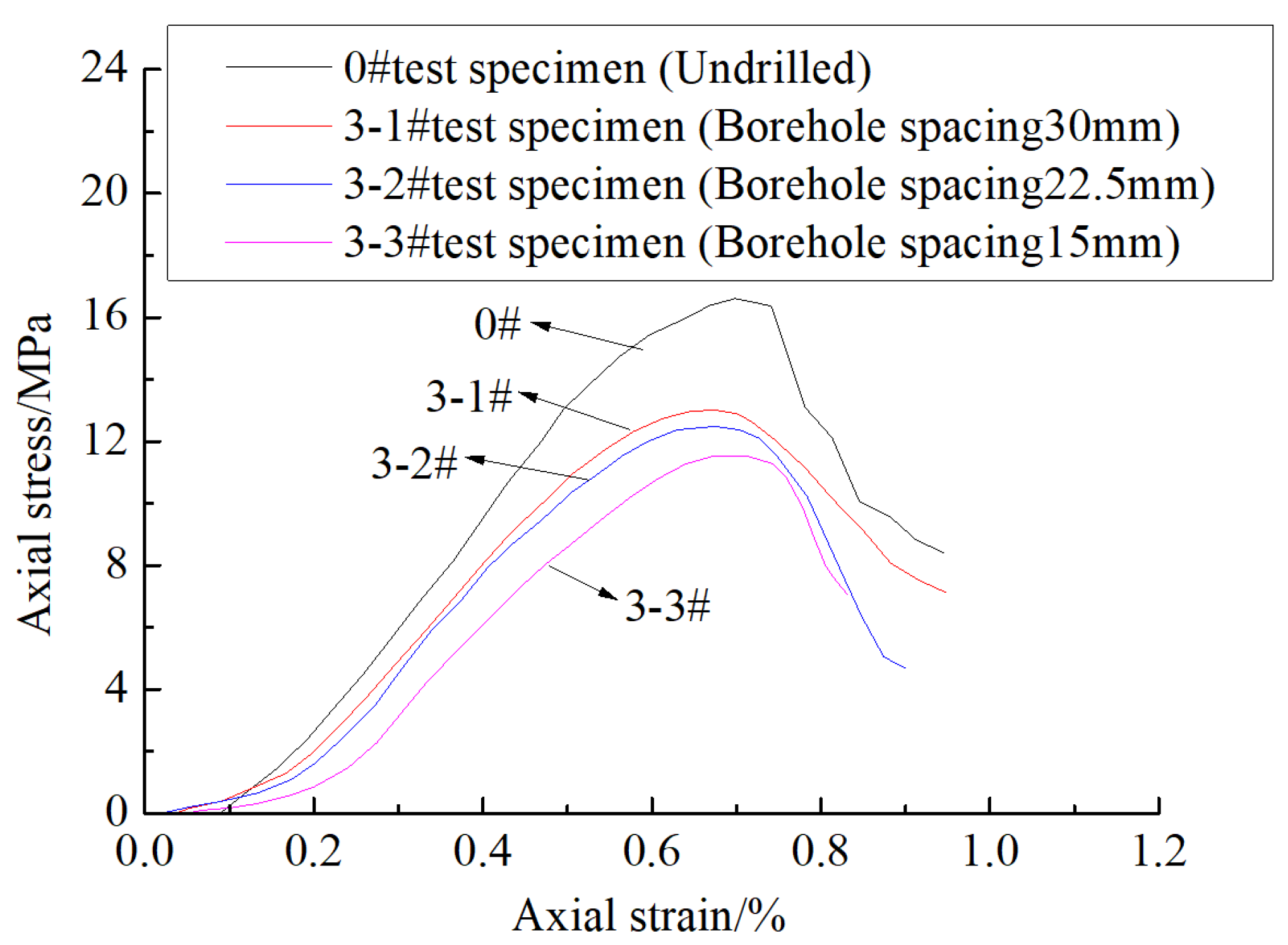
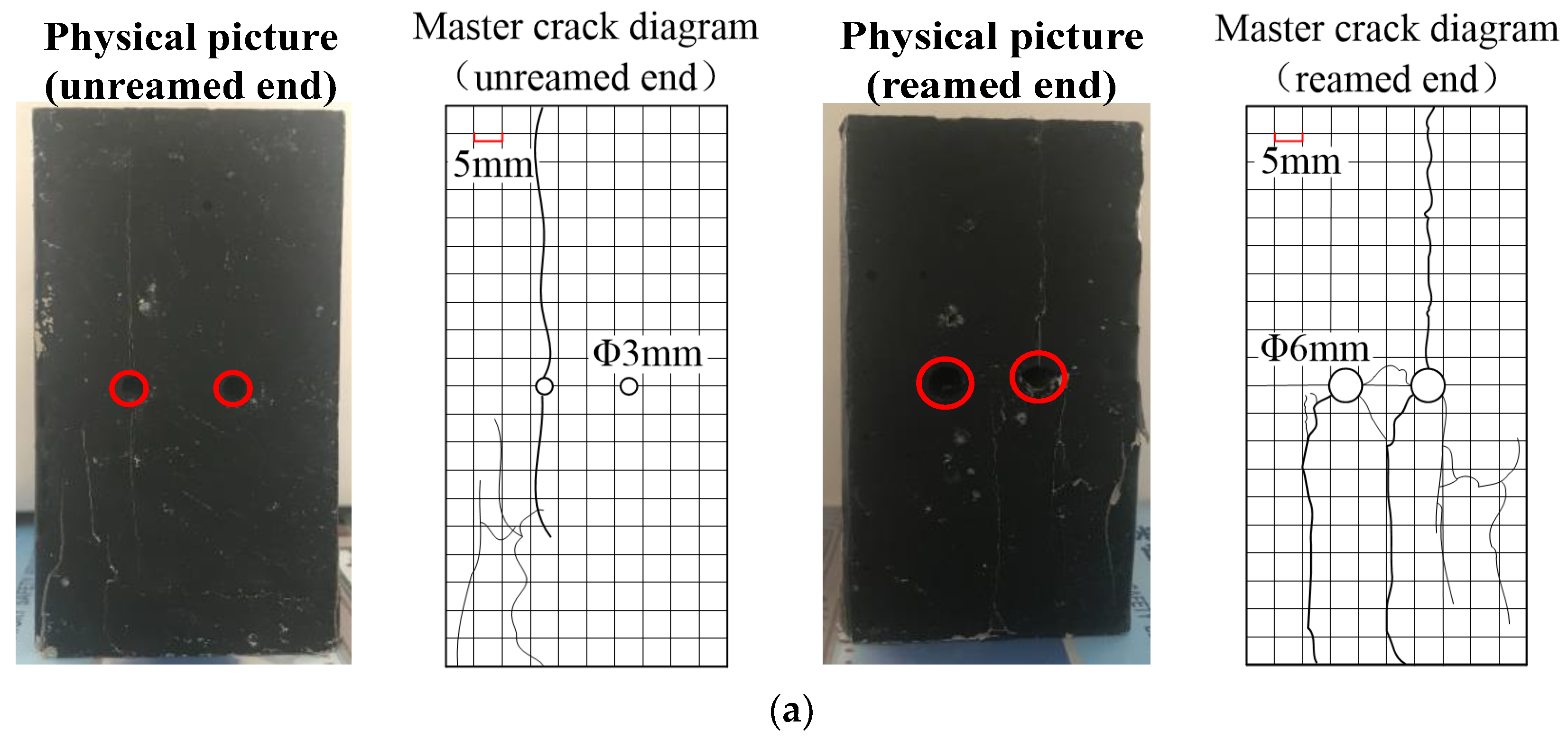

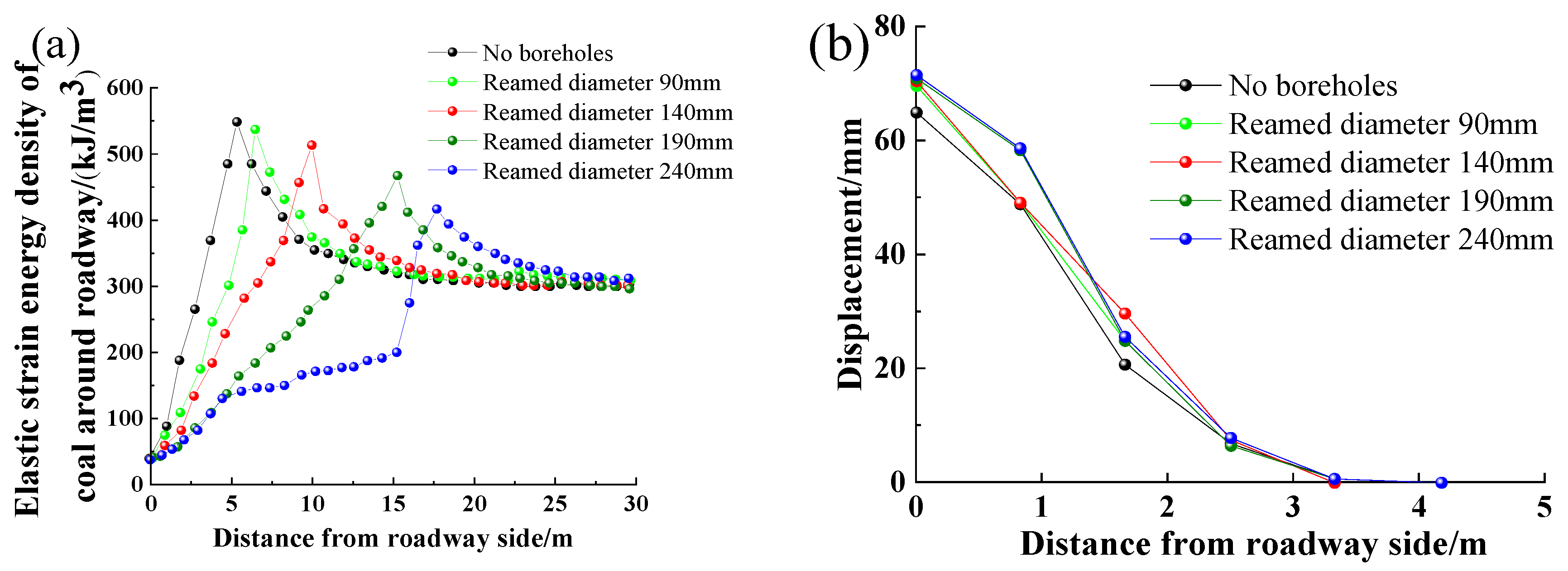
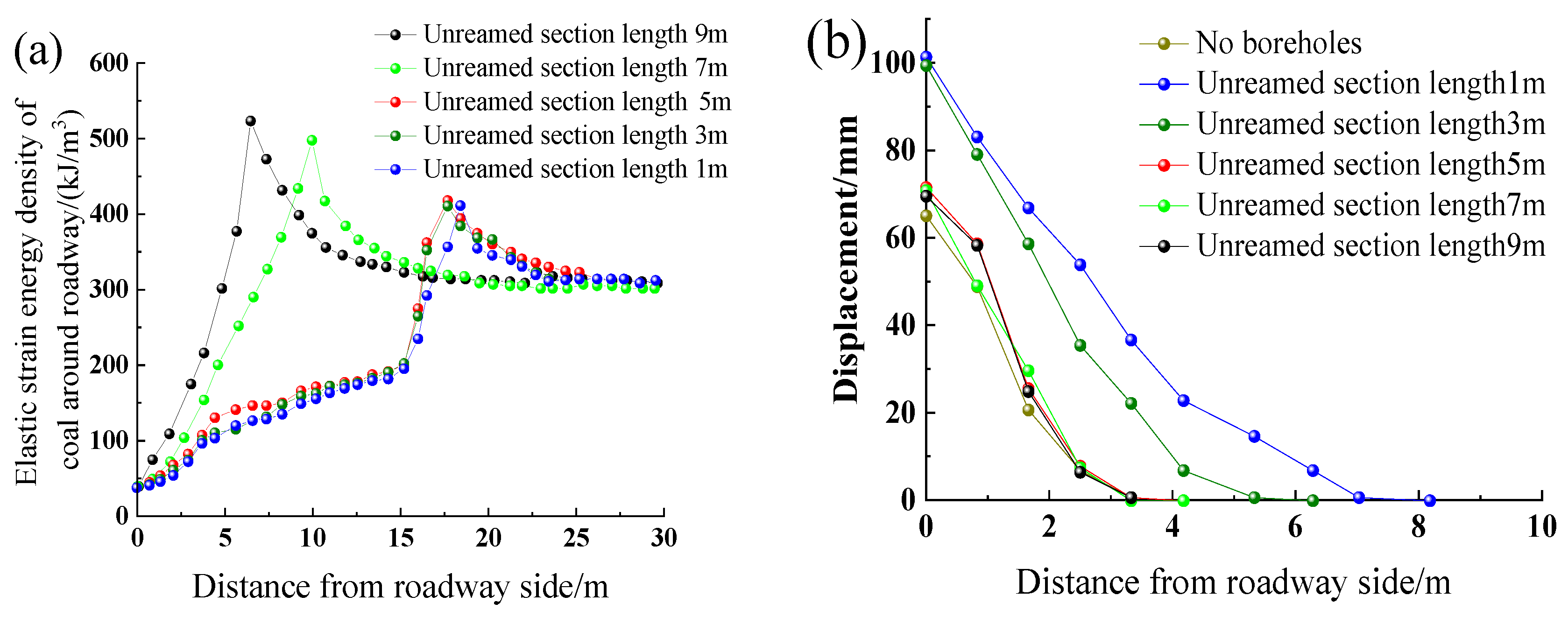



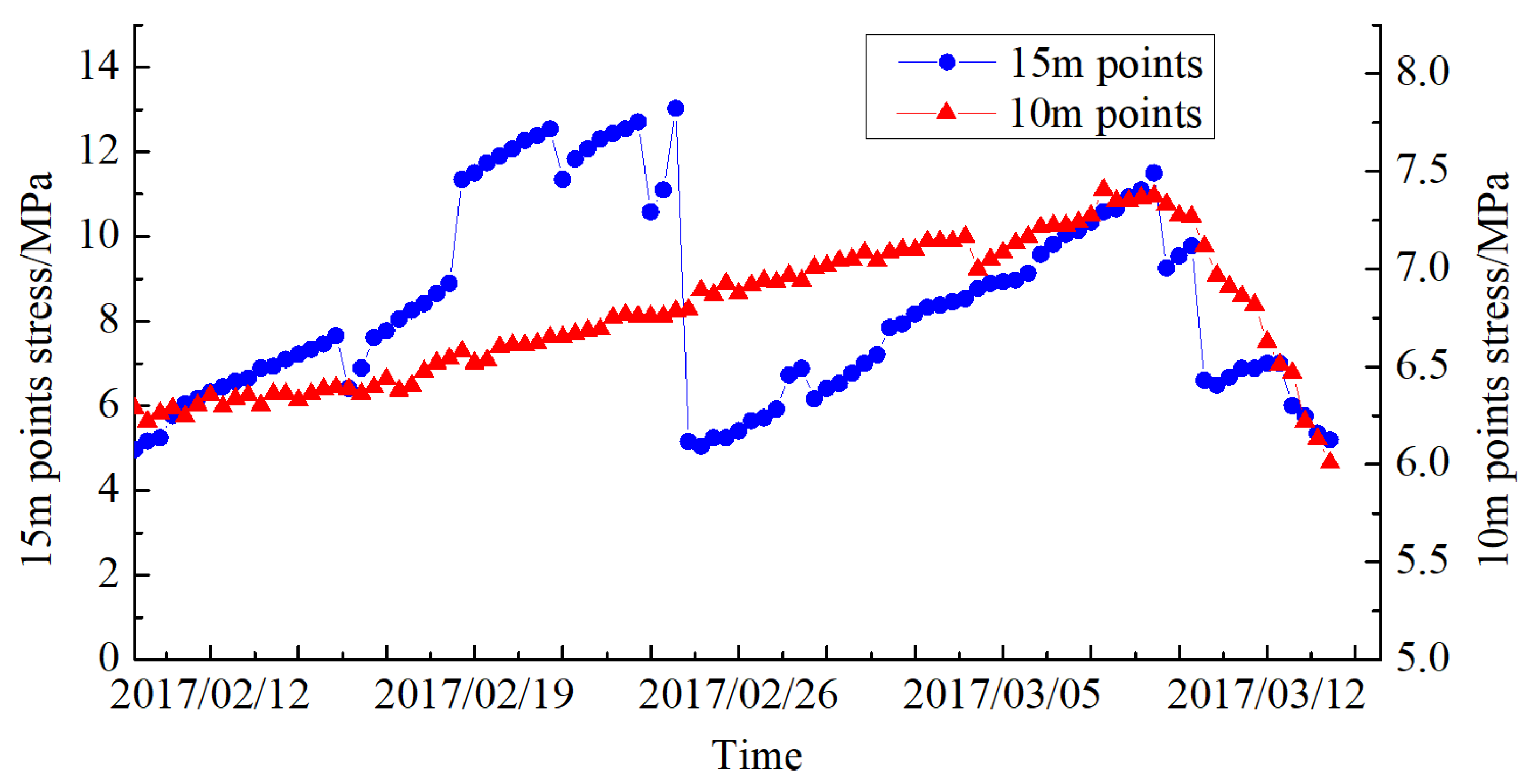
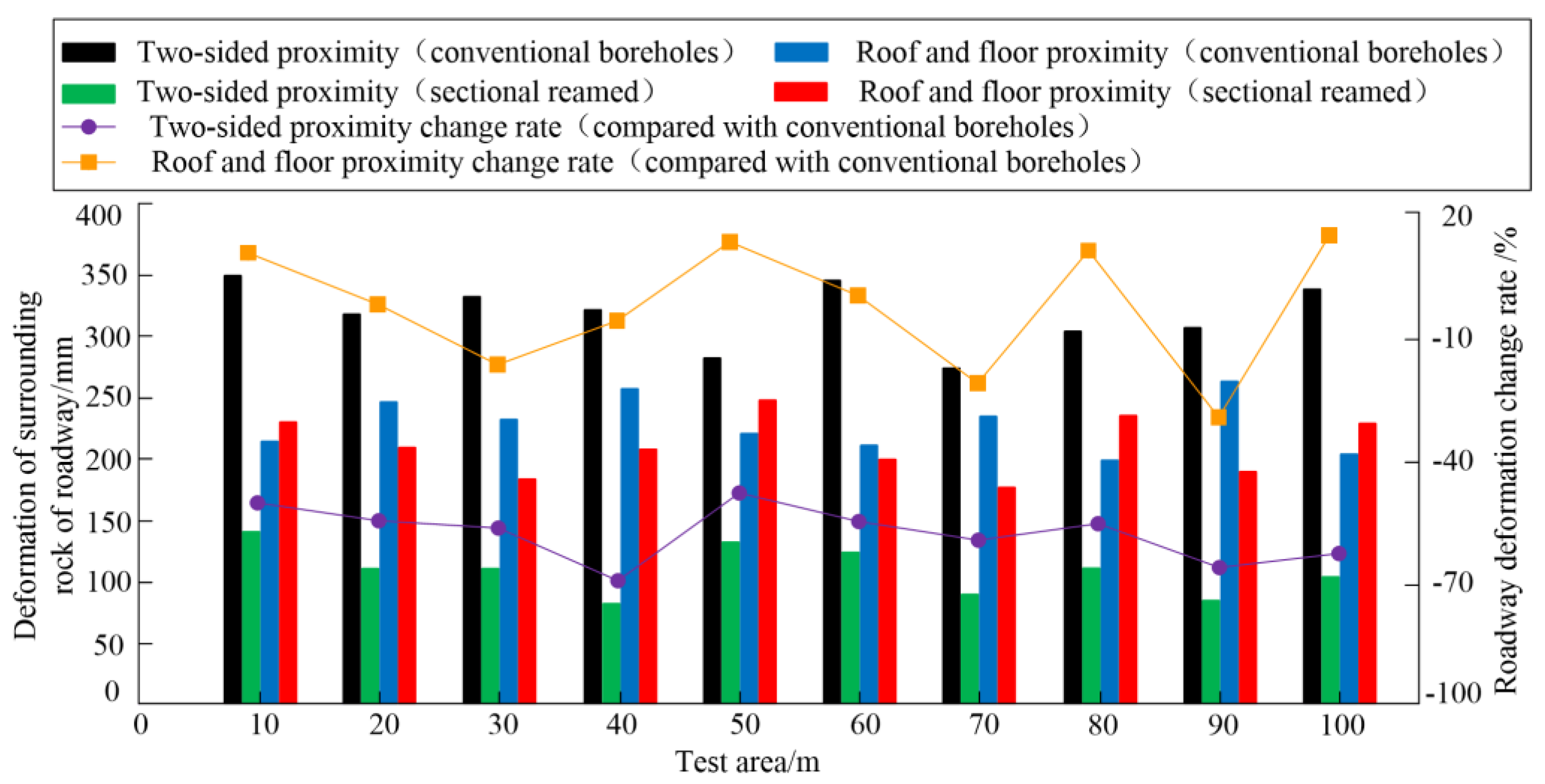
| Serial Number | Test Scheme | Parameter | Diagrammatic Sketch | Physical Pictures | ||||
|---|---|---|---|---|---|---|---|---|
| 1 | Different diameters of enlarged boreholes | 3 mm |  |  |  |  |  |  |
| 6 mm | ||||||||
| 9 mm | ||||||||
| 2 | Different boreholes enlargement depth | 15 mm |  |  |  |  |  |  |
| 25 mm | ||||||||
| 35 mm | ||||||||
| 3 | Different boreholes spacing | 15 mm |  |  |  |  |  |  |
| Serial Number | Drilling Depth (m) | Drill Hole Spacing (m) | Unexpanded Section | Reaming Section | ||
|---|---|---|---|---|---|---|
| Length (m) | Diameter (m) | Length (m) | Diameter (mm) | |||
| Simulation Scheme 1 | 20 | -- | 5 | 90 | 15 | 90, 140, 190, and 240 |
| Simulation Scheme 2 | 1.6 | 1, 3, 5, 7, and 9 | 90 | 19, 17, 15, 13, and 11 | 240 | |
| Simulation Scheme 3 | 0.8, 1.6, 2.4, and 3.2 | 5 | 90 | 15 | 90, 140, 190, and 240 | |
| Pressure Relief Technology | Conventional, Large-Diameter Boreholes Pressure Relief | Decompression by Piecewise Reaming |
|---|---|---|
| Boreholes diameter | 150 mm | 1–5 m is 90 mm; 5–20 m is 240 mm |
| Construction efficiency | Four in each class (considering sealing time) | Three in each class (no sealing time) |
| Drill pipe | Φ89 mm high-efficiency screw drill pipe | Φ63 mm wide blade drill pipe |
| Number of boreholes per hundred meters | 250 | 125 |
| Boreholes spacing | 0.8 m | 1.6 m |
| Single-borehole powder discharge | 0.55 t | 1.17 t |
| Coal powder discharge per meter of roadway | 0.34 t | 0.37 t |
| Construction time of single borehole | 2 h | 2.7 h |
| Construction efficiency | The construction of 20 boreholes in a 16-meter roadway requires 5 shifts and 11 tons of coal powder discharge | The construction of 10 boreholes in a 16-meter roadway requires 3.3 shifts and 11.7 tons of coal powder discharge |
Disclaimer/Publisher’s Note: The statements, opinions and data contained in all publications are solely those of the individual author(s) and contributor(s) and not of MDPI and/or the editor(s). MDPI and/or the editor(s) disclaim responsibility for any injury to people or property resulting from any ideas, methods, instructions or products referred to in the content. |
© 2023 by the authors. Licensee MDPI, Basel, Switzerland. This article is an open access article distributed under the terms and conditions of the Creative Commons Attribution (CC BY) license (https://creativecommons.org/licenses/by/4.0/).
Share and Cite
Wang, W.; Yuan, Y.; Ding, K.; Chen, Z.; Zhu, C.; Zhang, B.; Kofi, A.S.; Xia, Y.; Li, L. The Optimization of Segmented Reaming Parameters and the Analysis of the Pressure Relief Effect in Impacted Coal Seams. Processes 2023, 11, 1235. https://doi.org/10.3390/pr11041235
Wang W, Yuan Y, Ding K, Chen Z, Zhu C, Zhang B, Kofi AS, Xia Y, Li L. The Optimization of Segmented Reaming Parameters and the Analysis of the Pressure Relief Effect in Impacted Coal Seams. Processes. 2023; 11(4):1235. https://doi.org/10.3390/pr11041235
Chicago/Turabian StyleWang, Wenmiao, Yong Yuan, Ke Ding, Zhongshun Chen, Cheng Zhu, Beiyan Zhang, Anamor Samuel Kofi, Yongqi Xia, and Libao Li. 2023. "The Optimization of Segmented Reaming Parameters and the Analysis of the Pressure Relief Effect in Impacted Coal Seams" Processes 11, no. 4: 1235. https://doi.org/10.3390/pr11041235
APA StyleWang, W., Yuan, Y., Ding, K., Chen, Z., Zhu, C., Zhang, B., Kofi, A. S., Xia, Y., & Li, L. (2023). The Optimization of Segmented Reaming Parameters and the Analysis of the Pressure Relief Effect in Impacted Coal Seams. Processes, 11(4), 1235. https://doi.org/10.3390/pr11041235









